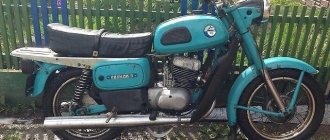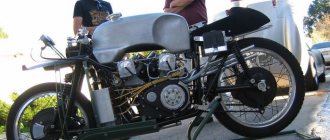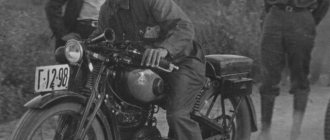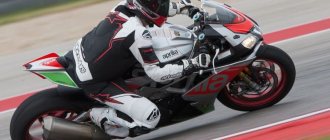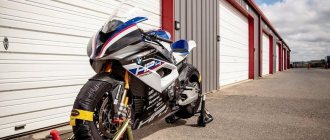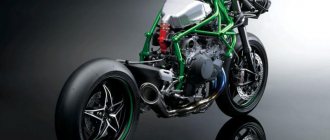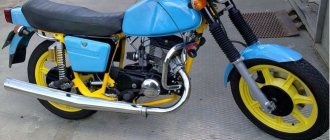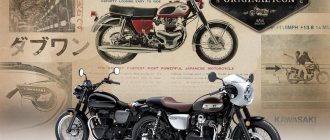DKW RT 125 1952
RT 125
There was a German two-stroke motorcycle made by DKW in Zschopau in the 1930s, MRS and MZK in the 1950s and early 1960s, and DKW in Ingolstadt in the 1950s and 1960s. "RT" stands for "Reichstyp" or "National Model".
In the 1930s, DKW pioneered the use of the Schnürle push-pull scavenging circuit to eliminate the use of a deflector piston and improve combustion chamber efficiency. DKW has also developed a highly efficient layout of the transhipment ports. These two features were included in the RT 125 with great commercial advantage. Competing companies such as Adler and TWN copied the introduction of flat-top pistons and sought to develop identical pumping mechanisms without infringing the DKW patent.
DKW RT 125-1 of the Wehrmacht, produced from 1943 to 1944
0
See all photos in the gallery
In 1922, Hermann Weber began his engineering work at the DKW plant in the city of Czopau. He was engaged in the design of motorcycles and was appointed chief designer of the plant. His first model was the light motorcycle DKW ZL (Zschopauer Leichtmotorrad). Weber also headed the DKW racing motorcycle department; in addition, he himself took part in sports motorcycle racing and was a repeated winner of a number of prestigious competitions. In 1932, DKW acquired a license from Adolf Schnürle for the method of loop purging of the cylinder of a two-stroke engine and the exclusive right to use it in gasoline engines. This patent was not used for two years until Weber designed a 97 cc engine. see power 2.5 hp for a motorcycle called RT-100. The engine was very successful and powerful for its cubic capacity. The new method of cylinder purging, successfully applied by Weber, made it possible to abandon the use of a deflector on the piston, increasing the efficiency of fuel combustion and engine power. Hermann Weber was the first to use a foot-operated gear shift on a motorcycle engine. The next motorcycle model is RT -125 with a 125 cc engine. see created by Weber in 1939, became revolutionary in the history of motorcycles. The DKW RT-125 model was the most copied motorcycle in the world; it was produced in different countries from 1940 to 1965. After the end of World War II, the city of Cshopau found itself in the zone of Soviet occupation. The DKW plant was dismantled and taken to the USSR as reparations. Herman Weber and a number of other plant workers were interned and sent to Izhevsk to set up production of the IZH-350 motorcycle (copies of the DKW NZ 350). In 1948, Hermann Weber died in Izhevsk.
2.
The story of four rings, or how German DKWs turned into Soviet motorcycles
The Belarusian State Museum of the History of the Great Patriotic War recently opened an exhibition “Traces of War”, where you can see the history of German and Soviet motorcycles. Its uniqueness lies in the fact that the rare wartime DKW equipment from the collection of Alexey Tikunov is present live. Read about how German DKWs turned into Soviet motorcycles in our material.
The exhibition “Traces of War” is a joint project of the museum and collector Alexei Tikunov . The motorcycle enthusiast's focus is on the wartime DKW models. After the main disaster of the 20th century, very few of them survived, but Alexey Tikunov literally piece by piece restored the motorcycles from original German spare parts. Moreover, the equipment is on the move, despite the difficult fate.
“Feel the frame from below with your hands,” says Alexey. — This DKW RT 125 fought - its entire rear part was cut by shrapnel. Apparently, at first he ran into a mine with his front wheel, the retarder worked - the explosion occurred under the rear wheel ... "
The breath of war is in every exhibit. How many tragedies and deaths have these motorcycles seen?
The exhibition is divided into blocks that reflect the beginning of the war, the retreat of the Germans and everyday life in the post-war years. The field repair area is allocated as a separate block. Accordingly, the equipment is in chronological order: first, DKW motorcycles are exhibited, and then Soviet models from the Moscow, Minsk and Izhevsk motorcycle factories.
“After the Treaty of Versailles in 1919, the Germans were very limited in their ability to develop military equipment,” says the collector. “That’s why they actively developed the types of equipment that were allowed. Nobody banned motorcycles, so German engineers made a big leap in the development of two-wheeled transport. During the war years, the motorcycle was assigned many different functions; the equipment was even used as a tractor.”
The motorcycle made it possible to motorize entire units relatively cheaply and economically. It was seen as a time-appropriate replacement for the riding horse on the battlefields. Therefore, two-wheeled vehicles were actively developed in Germany before the war. And DKW was one of the leaders in the motorcycle industry. In addition, cars were also produced here.
By the way, about the famous four rings. This badge dates back to 1932, when four manufacturers merged: Audi, DKW, Horch and Wanderer.
So, let's move on to the motorcycles themselves. The first exhibit is a DKW KS 200 manufactured in 1938. from the museum fund. It was created in 1936 specifically for young people. By purchasing this motorcycle, every young person received the opportunity to study for free at the DKW motorcycle school. A developed service network, a low price (540 Reichmarks), availability of spare parts - the motorcycles immediately “flew away” into hundreds of thousands of copies.
The DKW KS 200 was a lightweight version of the earlier SB 200. The tank of the motorcycle was smaller in volume compared to the SB 200, which was positioned as a touring bike. Their engines were similar: two-stroke 200 cc “single-barrel” engines with a power of 7 hp. Yes, in the photo we see two exhaust pipes, but this is specific to DKW engines equipped with a cylinder loop blowing system. The engines themselves are single-cylinder.
The DKW KS 200 was aimed at young buyers who liked to drive fast. The maximum speed is 90 km/h, which was very good for those times. The motorcycle was produced until 1940. Some of the copies, including this one, saw service in the war, although the KS 200 was not used at the front, only in the rear, since it turned out to be weak for real off-road use.
The next exhibit at the exhibition, the DKW NZ 350, was produced in 1938-1945 in various modifications. The ancestor of the Soviet Izhas had both civilian and army versions. The 346 cc two-stroke single-cylinder engine produced 11 hp.
“Some components were duplicated: the foot-operated gear shift lever had a manual override; using the ignition key, you could select the starting option with or without a battery,” comments Alexey. - That is, in any case, the soldier had to run away. The motorcycle weighs only 135 kilograms due to the fact that many parts, including the engine, are made of aluminum.”
This particular example is the 1941 Wehrmacht version. Only 2,500 of these motorcycles were produced, all of them went to the front.
“If we consider the Izh-350, produced in peacetime in the amount of 127,000 units, to be rare, then do you understand how unique this 1941 DKW NZ 350 is?”
Subject to slight “mutations,” the DKW NZ 350 was produced until the very end of World War II, in which it took an active part along with “four-stroke” models from BMW and Zundapp.
Every detail of the old motorcycle is a triumph of German pedantry.
“A German motorcycle is very easy to assemble,” says the restorer. — I have a catalog in which the design is described in great detail, down to every bolt. Here, for example, are branding bolts. This bike has over 100 of these Ribe and Verbus bolts. A German motorcycle is easy to assemble.”
Although with spare parts it’s not so simple. When restoring something, Alexey has to order a new one, since some of the parts simply physically cannot be preserved from those times. For example, the saddle came from Poland. An attempt to install the original tires failed because they exploded. Therefore, Alexey purchased new ones, since the Czech company producing motorcycle tires Mitas also produces retro tires. But mostly the parts are completely original. And precisely German-made, and not their Soviet copies.
In this regard, advice from MotoveloRetrodetal and Oldtimer Garage). Why not start producing parts for rare equipment using old machines? There is a demand for them in Europe. According to Alexey, spokes on M1A (DKW RT) and various rubber products such as handles and footrests would sell well.
“I couldn’t understand why it took me so long to find the tail on the rear wing,” says Alexey. — It turned out that the Germans simply threw them away when they became clogged with mud in Russia. The most interesting thing is that this tail was found separately from the motorcycle. By the way, all the tactical signs that you see on this part have been restored millimeter by millimeter.”
By the way, you can read more about the process of restoring these motorcycles on a specialized forum in the topics of user tikynoff.
Another interesting fact is that before being sent to the front or to the rear, motorcycles had to have a Siemens or Bosch approval for the absence of radio interference.
Go ahead. DKW RT 125, the prototype of our “Minskach”, appeared in 1939. It was a miniature copy of the DKW NZ-350. The front fork of a parallelogram design with a friction shock absorber, the power unit, and the frame are all very similar. But all its parts were miniature, giving the motorcycle a certain “toy-like” appearance. But the gear shift was foot-operated, which was a very progressive solution for that time.
The advantages of a motorcycle are simplicity, low cost, and reliability. A real Kalashnikov assault rifle in the field of motorcycle construction. If it had not been reliable, the Germans would have simply discontinued it during the war. All RT 125 models have a single-cylinder air-cooled engine with a displacement of 123 cc and power output ranging from 4.75 to 6.5 hp. (depending on version) with two-channel return purge. Maximum speed is from 75 to 90 km/h, weight is about 70 kg. There were both civilian RT 125 and versions for the Wehrmacht.
This is the most copied motorcycle of all time. After the war, its copies under different names were produced in the USSR, East Germany, Poland, India, Great Britain, USA (Harley-Davidson Hummer), Japan (Yamaha YA-1 - the first Yamaha motorcycle), Italy and Hungary.
This particular motorcycle is a simplified military version from 1941. It has the original tires and saddle. Even the light bulbs in the headlights are from 1941. Shrapnel wounds, a bullet hole - the motorcycle was clearly in trouble.
“The Germans have everything very clear,” comments Alexey Tikunov. — Why use a heavier 350 cc motorcycle in the rear when you can ride a small, economical 125 cc? Even Wilhelm Kube rode such a motorcycle.”
According to Alexey, the hardest thing is to find a signal for this motorcycle. It is plastic, so it easily cracked in the cold and broke when dropped. The signal has a stamp on it. As you already understand, in those years the Germans had everything they could mark: bolts, nipples, tire tubes, etc.
The next example is a military DKW NZ 350-1 WH from 1944. Having proven its necessity in the army, the “350th” in 1943 received a new military modification, which had some differences from the previous one. It had mudguards, an additional soft seat for the second number, and an inertia-type filter. In the last years of production, in order to save “winged metal” for aviation, the engine received a cast-iron crankcase, which made the motorcycle considerably heavier.
The signs say that you should not forget to mix gasoline with oil, and also not leave the key in the ignition in the parking lot, because there is a risk of the motorcycle being stolen by partisans. Interestingly, the DKW models had a gear indicator, although it was mechanical. However, not all modern motorcycles have this option!
And here is a late military DKW RT 125 WH from 1944. Its features are a rubber saddle, a cast-iron engine, steel legs, yokes made of thick tubes, etc.
In total, before the end of the war, the Wehrmacht received about 12,000 copies of the DKW RT 125 of all versions, thanks to which the model became one of the most popular army motorcycles. This particular DKW ran only 5,600 km until the Germans buried it during the retreat so that the equipment would not fall to the Soviet troops.
Also at the exhibition, a field workshop with various spare parts for German motorcycles is shown as a separate block.
Next in chronological order are Soviet motorcycles. By decision of the Allies, any enterprise that supplied weapons to the Wehrmacht was subject to dismantling. Therefore, as compensation for the damage caused to the national economy of the USSR, technical documentation and equipment from the DKW plant in the city of Zschopau were exported to the country. German engineers and some spare parts from warehouses were also delivered to the Soviet Union. This is how the RT 125 became the M1A “Moscow”, which was first produced at the Moscow Motorcycle Plant. Interestingly, sometimes on motorcycles from the first years of production there are German spare parts with original branding. In parallel with production in Moscow, a motorcycle under the name K-125 “Kovrovets” was also produced in the city of Kovrov, on the well-known ZiD.
In 1951, the production of M1A motorcycles was transferred from the Moscow Motorcycle Plant to the Minsk Bicycle Plant. This is how the first “Minskers” appeared. They were assembled from Moscow components, which explains the inscription “Moscow” on the gas tank. The inscription “Minsk” appeared in 1954, and a year before that the motorcycle had a telescopic fork and an alternating current generator, thanks to which it was possible to get rid of the battery.
The exhibition presents a copy from 1954. in “original” paint with a mileage of just over 5000 km.
The Minsk M-103 motorcycle is a further development of the M1A and M1M from the Minsk Motorcycle Plant. It was produced from 1961 to 1964.
IZH-350 was produced by the Izhevsk Machine-Building Plant in 1946-1951. It was a mixture of different versions of the German DKW NZ 350. Thus, the crankcase was made of aluminum alloy, like the early models, but the mud flaps and some other parts were like the later ones, produced already during the war. Basically, the early Soviet “Izhi” and “Minskach” are late army versions of the German DKW.
The motorcycle was adapted to domestic electrical equipment and instruments, but the general appearance and design were almost identical to the German original. For its time it was a modern, simple and reliable motorcycle.
From 1961 to 1966, IZH-Jupiter was produced. The roots of DKW are felt in it too... The engine here is two-cylinder, similar to the engine of the NZ 500 model.
Before the war, German design thought produced a number of motorcycles that were progressive for that time, which later turned into Soviet models. Visually this story can be seen in the museum - the exhibition will last until July 17. And Izh-350 and DKW-350-1 will participate in the Kola Chasu retro motorcycle festival, which will be held on June 25 near Minsk. The motorcycles are already fueled and ready for battle!
The venue for the fourth festival of rare motorcycles will be the Rowing Canal on the Zaslavsky Reservoir. Judging by the busy program, “Kola Chasu” should become one of the most exciting events of this summer.
Yuri GLADCHUK Photo by Olga-Anna KANASHITS ABW.BY
Minsk copy of MMVZ M1M “Minsk” (1951) MACACA…. that's what people called him
0
It was a great motorcycle - beautiful and reliable. In 1951, by order of the USSR Ministry of Automotive and Tractor Industry, M1A production was transferred from Moscow to Minsk to the Minsk Motorcycle and Bicycle Plant (MMVZ). The M1A was produced until 1956, when it was replaced by the modernized M1M model. The easiest way to distinguish the new model is by the different welded front and rear fenders, which received sunsets - a characteristic feature of motorcycles of those times. It is thanks to this feature that the M1M looks much more old-school than the M1A. Like M1A,
4.
Links[edit]
- Henshaw, Peter (2008-06-15). "1: Origins". BSA Bantam Bible. Velos Publishing House. pp. 12–15. ISBN 978-1-84584-159-1. Retrieved August 4, 2012.
- Henshaw, Peter (2008-06-15). "1: Origins". BSA Bantam Bible. Velos Publishing House. clause 11. ISBN 978-1-84584-159-1. Retrieved August 4, 2012.
- ↑
Alexander, Jeffrey W. (January 31, 2009). Japan's Motorcycle Wars: A History of the Industry. UBC Press. pp. 151–154. ISBN 978-0-7748-1454-6. Retrieved July 28, 2012. - ↑
Walker, Mick (1 November 2002). Racing motorcycles at the Japanese Grand Prix by Mick Walker. Redline Books. pp. 153–154. ISBN 0-9531311-8-1. Retrieved July 28, 2012. - Suprayitno, Micky (7 January 2013). "Classics: 1955 Yamaha 125Ya-1". GoMick
. Retrieved December 20, 2014.
American copy. Harley-Davidson "Hummer" (1959-1960).
0
There is probably no more legendary motorcycle brand than Harley-Davidson. Bikers all over the world know about them; they are still popular among fans of fast riding and collectors. There is not a single biker rally in the world where at least one Harley-Davidson would not be present. But in the fifties, Harley-Davidson was an ordinary, unremarkable motorcycle manufacturer. In 1948, the company released the Model 125, a small but reliable motorcycle with an air-cooled, two-stroke, single-cylinder engine. It had a three-speed manual transmission and three horsepower. The motorcycle was in the right place at the right time: post-war America needed a simple and economical vehicle. "Harley-Davidson 125" occupied this niche.
7.
Pre-war English copy of Royal Enfield RE 125
0
Any successful technology is always copied. The motorcycle industry is no exception in this regard. We can recall many examples, but the most striking is of course the DKW RT100. This motorcycle has sold many quotes in a large number of countries. The British have succeeded most here. And the first company to copy the successful German model was Royal Enfield. This story began with the fact that the Dutch importer DKW was suddenly denied goods from this company. The Germans were just busy with the final solution to the Jewish question, and the Dutch branch just belonged to the Jews. This happened in 1938. Left without German motorcycles, the Stokvis&Zonen trading house did not grieve too much; it sent its representatives to Royal Enfield with an offer to copy the DKW RT100. Well, the trading house Stokvis&Zonen took over the implementation on the continent and this enterprise promised big profits. The DKW RT100 sold very well. Royal Enfield chief designer Ted Pardo did an excellent job of copying. Royal Enfield prototypes differed little from the DKW RT100. Engine displacement was increased to 125 cubic meters, power 3.5 hp. But we had to abandon the return-loop purging of the cylinder. DKW held the patent for this technology and strictly ensured that no one used this technical solution without its knowledge. The first prototypes of the future motorcycle arrived in Holland in April 1939. The name Royal Baby was invented for the motorcycle. Then the war happened and the project was canceled. We remembered the motorcycle in 1942. The British Airborne Forces needed a small-capacity motorcycle for their courier service. It was assumed that the couriers would provide communication between units in the event that the radio could not be used. The motorcycle was modified to meet army requirements and adopted for service under the name Royal Enfield WD / RE Flying flea. A special transport container for parachute landing was developed for the motorcycle. Although the motorcycle was never parachuted. Flying flea were simply loaded into a landing glider in groups of four. Small dimensions and weight contributed to this. After the war, Flying flea production was not curtailed. The need for cheap vehicles was enormous. The civilian version was called Royal Enfield RE 125. This motorcycle had to compete with the BSA Bantam, an exact copy of the DKW RT125. BSA obtained the documentation and some of the equipment for this bike through reparations. In its original form, the Royal Enfield RE 125 was produced until 1947. Then the motorcycle underwent a slight modernization. A new telescopic front fork was installed on it. The RE 125 was discontinued in 1951. By that time, several more modern models had been created based on this motorcycle.
8.
Post-war English copy of the BSA Bantam. "BSA-D1" (1948-1951)
0
MIRROR IMAGE In a brilliant piece of adaptive engineering, BSA "flipped" or reversed the entire engine design, creating a mirror image of the original. This was done to move the shift lever and kickstarter to the right side where God intended them to be. They also converted the whole thing from metric to inches and added imperial electrical (oh my!).
9.
Sokoł 125 (1947)
0
There was no Polish motorcycle industry after World War II. Technical documentation and factory equipment were destroyed or requisitioned. Fortunately, many inventors managed to survive. When the new government decided to start producing motorcycles - the decision was made on July 1, 1946 - the designers immediately got to work. Time was short, so the new motorcycle had to be based on an earlier successful design. DKW RT 125 was selected; without a doubt a good choice. IFA, Moskwa, BSA, even Harley-Davidson also copied it.
11.
Copies and variants[edit]
Copies of the RT 125 were built by at least eight different organizations in at least six countries.
Compensation [edit]
See also: BSA Bantam, Harley-Davidson Hummer, MMZ (motorcycle), Minsk (motorcycle), and SHL (motorcycle)
After World War II, the Soviet Union took plans, tooling, and even a few dozen employees as war reparations for MMZ in Moscow (later transferred to MMZ and SMZ) and the Kovrov plant, and produced copies of the RT 125 as the M1A Moskva and K-125 respectively. The Polish company WFM created a modified version of the RT 125 (under the SHL 125 and Sokół 125 brands), developed into 125/175 cc family motorcycles produced until 1985.
Plans for the RT 125 were also brought to the United Kingdom, where they became the basis of the BSA Bantam, and to the United States, where they formed the basis of the Harley-Davidson "Hummer" (the Hummer is really only a few years old, but people generally refer to lightweight Hummers as Harleys).
Motorcycles based on RT 125 from war reparations
- Motorcycle Minsk, modification of the Soviet-built RT 125
- Motorcycle Sokół 125, produced in Poland from 1947 to 1950
- Motorcycle SHL M04, produced in Poland from 1948 to 1952.
- 1955 BSA Bantam D3 Major
- Harley-Davidson Hummer. Harley-Davidson produced modifications of the RT 125 from 1948 to 1966.
Post-war German production: DKW and MZ[edit]
After World War II, the DKW factories in Žshopau were located in the Soviet occupation zone. Thus, they were under the control of the Soviet Union until they were handed over to the East German government. The plant continued production of the RT 125 under the MZ brand ( Motorradwerk Zschopau
) until the 1950s. [1]
In the meantime, DKW reorganized in Ingolstadt, where it began production of the RT 125W (for "West") in 1949. Variants of the RT 125W, usually with larger engines, were produced throughout the 1950s. [2]
Post-war German RT 125
- DKW RT 125 W, post-war West German version of the RT 125
- IFA/DKW 125 RT, built in Zschopau, East Germany (1954-1956)
- 1961 MZ RT 125/3 built in Zschopau, East Germany
Yamaha YA-1[edit]
Main article: Yamaha YA-1
Yamaha Ya-1
In the 1950s, following the re-establishment of musical instrument production, Nippon Gakki decided to use production equipment left over from wartime production to produce motorcycles. Since the RT 125's copyright was revoked by the Allies, the company developed it as the basis for its first motorcycle. Nippon Gakki formed the Yamaha Motor Company in 1955 to create its copy of the RT 125 called the Yamaha YA-1, which was produced from 1955 to 1958. The YA-1 inherited the design characteristics of the RT 125 and, thanks to its thin hull, a chestnut-brown tank affectionately nicknamed Aka-tombo (赤トンボ, "Red Dragonfly"). [3][4] [5]
